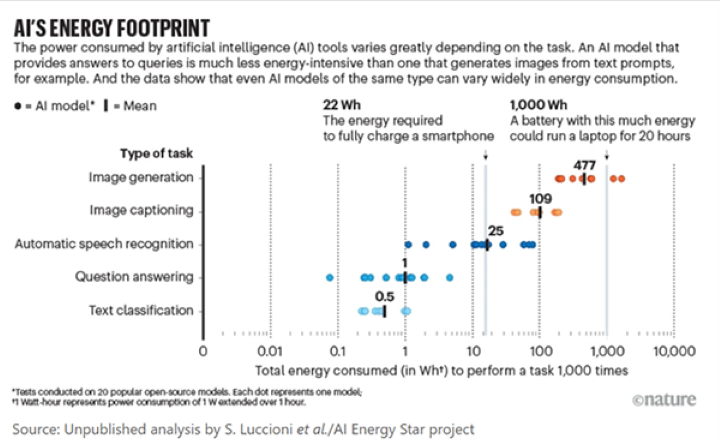5 Environmental impact

As discussed in the first course, GenAI tools rely on data centres which require vast amounts of energy and water to work. At a time when many organisations are looking to reduce their carbon footprint, and countries are working towards net zero, the environmental impact of the increasing use of GenAI tools is problematic.
The energy demands of GenAI are so high that Microsoft has taken out a 20-year contract to use energy from the nuclear reactor at Three Mile Island. The 2024 AI Trends report (So, 2024) raised concerns that the demand for power from these companies is outpacing the ability of utilities to expand capacity. The resulting energy gap could become a bottleneck and limit the growth of AI and other power-intensive applications.
In addition to energy use, computers also produce heat – and data centres produce a lot of heat. Water is commonly used to transfer that heat out of the centre. An average hyperscale data centre, such as those used for training AI models, uses around 550,000 gallons (2.1 million litres) of water daily. This is especially concerning considering that these data centres are often located in areas with limited water supply. One estimate suggests that by 2027 the cooling demands of AI would be more than half the total annual water consumption of the United Kingdom.
However, it can be difficult to get accurate or complete data on environmental impacts as precise numbers are closely guarded by tech companies and are often under-documented.
When using a GenAI tool, there is also a difference in energy consumption depending on the task. In general, supervised tasks such as question answering or text classification – in which models are provided with a set of options to choose from or a document that contains the answer – are much more energy efficient than generative tasks that rely on the patterns learnt from the training data to produce a response from scratch (Luccioni et al., 2024). In addition, the energy required for image generation is considerably higher than that needed for question answering.
So, what can individuals do to reduce the environmental impact of using GenAI tools? As different types of AI vary in their environmental footprint, choosing the right tool for the task will minimise the environmental impact and energy costs.
 Do you know the environmental impact of using GenAI tools?
Do you know the environmental impact of using GenAI tools?
Answer the three questions below.
a.
The same as turning on an LED lightbulb for five minutes
b.
The same as boiling a kettle
c.
The same as using a hairdryer for five minutes
The correct answer is b.
a.
20 times
b.
40 times
c.
60 times
The correct answer is c.
a.
The same as fully charging your smart phone
b.
The same as using a hairdryer for five minutes
c.
The same as boiling a kettle
The correct answer is a.
The image below shows the total power consumed by different AI tools when completing different tasks.
Generally, using a general internet search engine instead of GenAI is much more energy efficient. Individuals should therefore ask themselves if they need to use GenAI for the task or whether other tools would work as well and be less energy intensive.
As well as thinking carefully about the right tool for the task, crafting effective AI prompts can minimise unnecessary prompting and reduce environmental impact. If you have not already done so, you may want to look at the second course, Skills and strategies for using Generative AI.
Having explored a range of different ethical concerns regarding GenAI use, the next section will now consider why this is important for individuals and organisations.
4 Societal concerns




